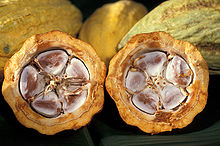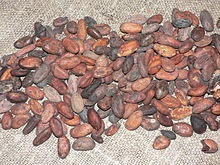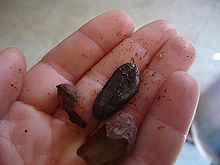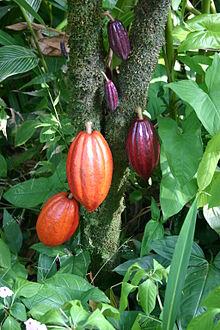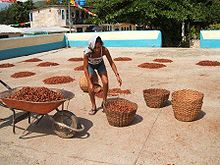
Cocoa bean
About this schools Wikipedia selection
The articles in this Schools selection have been arranged by curriculum topic thanks to SOS Children volunteers. SOS Children works in 45 African countries; can you help a child in Africa?
Cacao bean (also Anglicized as cocoa bean, often simply cocoa (pron.: / ˈ k oʊ . k oʊ /) and cacao ( / k ə ˈ k aʊ /); Mayan: kakaw; Nahuatl: cacahuatl [ka'kawat͡ɬ]) is the dried and fully fermented fatty bean of Theobroma cacao, from which cocoa solids and cocoa butter are extracted. They are the basis of chocolate, as well as many Mesoamerican foods such as mole sauce and tejate.
A cocoa pod (fruit) has a rough and leathery rind about 3 cm thick (this varies with the origin and variety of pod). It is filled with sweet, mucilaginous pulp (called 'baba de cacao' in South America) enclosing 30 to 50 large seeds that are fairly soft and white to a pale lavender colour. While seeds are usually white, they become violet or reddish brown during the drying process. The exception is rare varieties of white cacao, in which the seeds remain white. Historically, white cacao was cultivated by the Rama people of Nicaragua.
Etymology
Cocao is the Anglicized spelling of the Spanish word cacao, derived from the Nahuatl word cacahuatl. Cocoa can often also refer to the drink commonly known as hot chocolate; to cocoa powder, the dry powder made by grinding cocoa seeds and removing the cocoa butter from the dark, bitter cocoa solids; or to a mixture of cocoa powder and cocoa butter.
History
The cacao tree is native to the Americas. It may have originated in the foothills of the Andes in the Amazon and Orinoco basins of South America, current day Venezuela, where today, examples of wild cacao still can be found. However, it may have had a larger range in the past, evidence for which may be obscured because of its cultivation in these areas long before, as well as after, the Spanish arrived. It was first cultivated by the Olmecs at least 1500 BC in Mexico.
The cocoa bean was a common currency throughout Mesoamerica before the Spanish conquest.
Cacao trees will grow in a limited geographical zone, of approximately 20 degrees to the north and south of the Equator. Nearly 70% of the world crop is grown in West Africa.
Cocoa was an important commodity in pre-Columbian Mesoamerica. A Spanish soldier who was part of the conquest of Mexico by Hernán Cortés tells that when Moctezuma II, emperor of the Aztecs, dined, he took no other beverage than chocolate, served in a golden goblet. Flavored with vanilla or other spices, his chocolate was whipped into a froth that dissolved in the mouth. It is reported that no fewer than 60 portions each day may have been consumed by Moctezuma II, and 2000 more by the nobles of his court.
Chocolate was introduced to Europe by the Spaniards, and became a popular beverage by the mid 17th century. They also introduced the cacao tree into the West Indies and the Philippines. It was also introduced into the rest of Asia and into West Africa by Europeans. In the Gold Coast, modern Ghana, cacao was introduced by an African, Tetteh Quarshie.
The cacao plant was first given its botanical name by Swedish natural scientist Carl Linnaeus in his original classification of the plant kingdom, who called it Theobroma ("food of the gods") cacao.
Production
World production
| Top Cocoa Beans Producers in 2010 |
|
| (million metric tons) | |
| 1.242 | |
| 0.844 | |
| 0.632 | |
| 0.360 | |
| 0.264 | |
| 0.235 | |
| 0.132 | |
| 0.102 | |
| 0.058 | |
| 0.047 | |
| World Total | 4.082 |
| Source: UN Food & Agriculture Organisation (FAO) |
|
More than 3,000,000 tonnes (3,000,000 long tons; 3,300,000 short tons) of cocoa are produced each year. The global production was
-
- 1974: 1,556,484 tons,
- 1984: 1,810,611 tons,
- 1994: 2,672,173 tons,
- 2004: 3,607,052 tons.
The production increased by 131.7% in 30 years, representing a compound annual growth rate of 2.9%.
There are three main varieties of cocoa plant: Forastero, Criollo, and Trinitario. The first is the most widely used, comprising 95% of the world production of cocoa. Overall, the highest quality cocoa beans come from the Criollo variety, which is considered a delicacy. Criollo plantations have lower yields than those of Forastero, and also tend to be less resistant to several diseases that attack the cocoa plant, hence very few countries still produce it. One of the largest producers of Criollo beans is Venezuela (Chuao and Porcelana). Trinitario is a hybrid between Criollo and Forastero varieties. It is considered to be of much higher quality than the latter, but has higher yields and is more resistant to disease than the former.
There are different metrics used for chocolate consumption. The Netherlands has the highest monetary amount of cocoa bean imports (US$2.1 billion); it is also one of the main ports into Europe. The United States has highest amount of cocoa powder imports ($220 million); the US has a large amount of cocoa complementary products. The United Kingdom has the highest amount of retail chocolate ($1.3 billion) and is one of the biggest chocolate consumption per capita markets.
Cocoa and its products (including chocolate) are used worldwide. Per capita consumption is poorly understood, with numerous countries claiming the highest: various reports state Switzerland, Belgium, and the UK have the highest consumption, but it can be claimed that because there is no clear mechanism to determine how much of a country's production is consumed by residents and how much by visitors, this is all speculative.
There were 3.54 million tonnes of cocoa beans produced in the 2008–2009 growing year, which runs from October to September. Of this total, African nations produced 2.45 million tonnes (69%), Asia and Oceania produced 0.61 million tonnes (17%) and the Americas produced 0.48 million tonnes (14%). Two African nations, Côte d'Ivoire and Ghana, produce more than half of the world's cocoa, with 1.23 and 0.73 million tonnes respectively (35% and 21%, respectively). The largest cocoa bean-producing countries in the world are as follows.
| Country | Amount produced | Percentage of world production |
|---|---|---|
| Côte d'Ivoire | 1.23 million tons | 34.7% |
| Ghana | 746 thousand tons | 20.6% |
| Indonesia | 489 thousand tons | 13.8% |
| Cameroon | 220 thousand tons | 5.9% |
| Nigeria | 210 thousand tons | 5.9% |
| Brazil | 165 thousand tons | 4.7% |
| Ecuador | 130 thousand tons | 3.7% |
| Malaysia | 32 thousand tons | 0.9% |
Harvesting
Cocoa trees grow in hot, rainy tropical areas within 20° of latitude from the equator. Cocoa harvest is not restricted to one period per year. Usually it occurs over several months and in many countries cocoa can be harvested at any time of the year. Pesticides are often applied to the trees to combat capsid bugs and fungicides to fight black pod disease.
Immature cocoa pods have a variety of colors but most often are green, red, or purple, and as they mature their color tends towards yellow or orange, particularly in their creases. Unlike most fruiting trees, the cacao pod grows directly from the trunk or large branch of a tree rather than from the end of a branch. This makes harvesting by hand easier as most of the pods will not be up in the higher branches. The pods on a tree do not ripen together; harvesting needs to be done periodically through the year. Harvesting occurs between 3–4 times to weekly during the harvest season. The ripe and near-ripe pods, as judged by their colour, are harvested from the trunk and branches of the cocoa tree with a curved knife on a long pole. Care must be used when cutting the stem of the pod to avoid injuring the junction of the stem with the tree, as this is where future flowers and pods will emerge. It is estimated one person can harvest 650 pods per day.
Harvest processing
The harvested pods are opened —typically with a machete— to expose the beans. The pulp and cocoa seeds are removed and the rind is discarded. The pulp and seeds are then piled in heaps, placed in bins, or laid out on grates for several days. During this time, the seeds and pulp undergo "sweating", where the thick pulp liquefies as it ferments. The fermented pulp trickles away, leaving cocoa seeds behind to be collected. Sweating is important for the quality of the beans, which originally have a strong bitter taste. If sweating is interrupted, the resulting cocoa may be ruined; if underdone, the cocoa seed maintains a flavor similar to raw potatoes and becomes susceptible to mildew. Some cocoa producing countries distil alcoholic spirits using the liquefied pulp.
A typical pod contains 20 to 50 beans and about 400 dried beans are required to make one pound (880 per kilogram) of chocolate. Cocoa pods weigh an average of 400 grams (0.88 lb) and each one yields 35 to 40 grams (1.2 to 1.4 oz) dried beans (this yield is 40–44% of the total weight in the pod). It is estimated one person can separate the beans from 2000 pods per day.
The wet beans are transported then to a facility so they can be fermented and dried. They are fermented for four to seven days and must be mixed every two days. They are dried for five to fourteen days, depending on the climate conditions. The fermented beans are dried by spreading them out over a large surface and constantly raking them. In large plantations, this is done on huge trays under the sun or by using artificial heat. Small plantations may dry their harvest on little trays or on cowhides. Finally, the beans are trodden and shuffled about (often using bare human feet) and sometimes, during this process, red clay mixed with water is sprinkled over the beans to obtain a finer colour, polish, and protection against molds during shipment to factories in the United States, the Netherlands, United Kingdom, and other countries. Drying in the sun is preferable to drying by artificial means, as no extraneous flavours such as smoke or oil are introduced which might otherwise taint the flavor.
The beans should be dry for shipment (usually by sea). Traditionally exported in jute bags, over the last decade the beans are increasingly shipped in 'Mega-Bulk' bulk parcels of several thousand tonnes at a time on ships, or in smaller lots of around 25 tonnes in 20 foot containers. Shipping in bulk significantly reduces handling costs; shipment in bags, however, either in a ship's hold or in containers, is still commonly found.
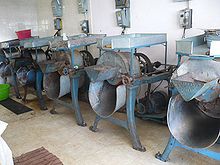
Throughout Mesoamerica where they are native, cocoa beans are used for a variety of foods. The harvested and fermented beans may be ground to-order at tiendas de chocolate, or chocolate mills. At these mills, the cocoa can be mixed with a variety of ingredients such as cinnamon, chili peppers, almonds, vanilla and other spices to create drinking chocolate. The ground cocoa is also an important ingredient in tejate and a number of savory foods, such as mole.
Chocolate production
To make 1 kg (2.2 pounds) of chocolate, about 300 to 600 beans are processed, depending on the desired cocoa content. In a factory, the beans are roasted. Next they are cracked and then de-shelled by a "winnower". The resulting pieces of beans are called nibs. They are usually sold in small packages at specialty stores and markets to be used in cooking, snacking and chocolate dishes. Since nibs are directly from the cocoa tree, they contain high amounts of theobromine. Most nibs are ground, using various methods, into a thick creamy paste, known as chocolate liquor or cocoa paste. This "liquor" is then further processed into chocolate by mixing in (more) cocoa butter and sugar (and sometimes vanilla and lecithin as an emulsifier), and then refined, conched and tempered. Alternatively, it can be separated into cocoa powder and cocoa butter using a hydraulic press or the Broma process. This process produces around 50% cocoa butter and 50% cocoa powder. Standard cocoa powder has a fat content of approximately 10–12 percent. Cocoa butter is used in chocolate bar manufacture, other confectionery, soaps, and cosmetics.
Treating with alkali produces Dutch process cocoa powder, which is less acidic, darker and more mellow in flavor than what is generally available in most of the world. Regular (non-alkalized) cocoa is acidic, so when cocoa is treated with an alkaline ingredient, generally potassium carbonate, the pH increases. This process can be done at various stages during manufacturing, including during nib treatment, liquor treatment or press cake treatment.
Another process that helps develop the flavor is roasting. Roasting can be done on the whole bean before shelling or on the nib after shelling. The time and temperature of the roast affect the result: A "low roast" produces a more acid, aromatic flavor, while a high roast gives a more intense, bitter flavor lacking complex flavor notes.
Health benefits of cocoa consumption
Chocolate and cocoa contain a high level of flavonoids, specifically epicatechin, which may have beneficial cardiovascular effects on health.
Prolonged intake of flavanol-rich cocoa has been linked to cardiovascular health benefits, though it should be noted that this refers to raw cocoa and to a lesser extent, dark chocolate, since flavonoids degrade during cooking and alkalizing processes. Studies have found short term benefits in LDL cholesterol levels from dark chocolate consumption. The addition of whole milk to milk chocolate reduces the overall cocoa content per ounce while increasing saturated fat levels, possibly negating some of cocoa's heart-healthy potential benefits. Although one study has concluded that milk impairs the absorption of polyphenolic flavonoids, e.g. (-)epicatechin, a followup failed to find the effect.
Hollenberg and colleagues of Harvard Medical School studied the effects of cocoa and flavanols on Panama's Kuna people, who are heavy consumers of cocoa. The researchers found that the Kuna Indians living on the islands had significantly lower rates of heart disease and cancer compared to those on the mainland who do not drink cocoa as on the islands. It is believed that the improved blood flow after consumption of flavanol-rich cocoa may help to achieve health benefits in hearts and other organs. In particular, the benefits may extend to the brain and have important implications for learning and memory.
Foods rich in cocoa appear to reduce blood pressure but drinking green and black tea may not, according to an analysis of previously published research in the April 9, 2007 issue of Archives of Internal Medicine, one of the JAMA/Archives journals.
In June 2009, Mars Botanicals, a division of Mars Inc., the candymaker and food company, launched Cirku, a cocoa extract high in flavanols.
A 15-year study of elderly men published in the Archives of Internal Medicine in 2006 found a 50 percent reduction in cardiovascular mortality and a 47 percent reduction in all-cause mortality for the men regularly consuming the most cocoa, compared to those consuming the least cocoa from all sources.
Animal consumption
Chocolate is a food product with appeal not only to the human population, but to many different animals as well. However, chocolate and cocoa contain a high level of xanthines, specifically theobromine and to a much lesser extent caffeine, that are detrimental to the health of many animals, including dogs and cats. While these compounds have desirable effects in humans, they cannot be efficiently metabolized in many animals and can lead to cardiac and nervous system problems, and if consumed in high quantities, even lead to death. However, since the beginning of the 21st century, some cocoa derivatives with a low concentration of xanthines have been designed by specialized industry to be suitable for pet consumption, enabling the pet food industry to offer animal-safe chocolate and cocoa flavored products. It results in products with a high concentration of fibre and proteins, while maintaining low concentrations of sugar and other carbohydrates, thus enabling it to be used to create healthy functional cocoa pet products.
Child labor
The first allegations that child slavery is used in cocoa production appeared in 1998. In late 2000 a BBC documentary reported the use of enslaved children in the production of cocoa in West Africa. Other media followed by reporting widespread child slavery and child trafficking in the production of cocoa. According to a report by the International Labour Organization (ILO), in 2002, more than 109,000 children were working on cocoa farms in Côte d'Ivoire (Ivory Coast), some of them in "the worst forms of child labour". The ILO later reported that 200,000 children were working in the cocoa industry in Côte d'Ivoire in 2005. The 2005 ILO report failed to fully characterize this problem, but estimated that up to 6% of the 200,000 children involved in cocoa production could be victims of human trafficking or slavery. The cocoa industry was accused of profiting from child slavery and trafficking. The Harkin-Engel Protocol is an effort to end these practices. It was signed and witnessed by the heads of eight major chocolate companies, Harkin, Engel, Senator Herb Kohl, the ambassador of the Ivory Coast, the director of the International Programme on the Elimination of Child Labor, and others. It has, however, been criticized by some groups including the International Labor Rights Forum as an industry initiative which falls short.
Fairtrade
- There are Fairtrade cocoa producer groups in Belize, Bolivia, Cameroon, The Congo, Costa Rica, Dominican Republic, Ecuador, Ghana, Haiti, India, Côte d'Ivoire, Nicaragua, Panama, Peru, Sierra Leone and Sao Tome & Principe.
- As of 2005, less than 1% of the chocolate market was Fair Trade.
- Cadbury, one of the world's largest chocolate companies, has begun certifying its Dairy Milk bars as Fair Trade; according to Cadbury, in 2010 "around one quarter of ... global sales" of these bars will be Fair Trade .
Environmental impact
The relative poverty of many cocoa farmers means that environmental consequences such as deforestation are given little significance.
For decades, cocoa farmers have encroached on virgin forest, mostly after the felling of trees by logging companies.
This trend has decreased as many governments and communities are beginning to protect their remaining forested zones.
In general, the use of chemical fertilizers and pesticides by cocoa farmers is limited. When cocoa bean prices are high, farmers may invest in their crops, leading to higher yields which, in turn tends to result in lower market prices and a renewed period of lower investment.
Cocoa trading
Cocoa beans, cocoa butter and cocoa powder are traded on two world exchanges: NYSE Euronext and IntercontinentalExchange (ICE). The London market is based on West African cocoa and New York on cocoa predominantly from Southeast Asia. Cocoa is the world's smallest soft commodity market.
The future price of cocoa butter and cocoa powder is determined by multiplying the bean price by a ratio. The combined butter and powder ratio has tended to be around 3.5. If the combined ratio falls below 3.2 or so, production ceases to be economically viable and some factories cease extraction of butter and powder and trade exclusively in cocoa liquor.
Cocoa beans can be held in storage for several years in bags or in bulk, during which the ownership can change several times, as the cocoa is traded much the same as metal or other commodities, to gain profit for the owner.
In July 2010, British hedge fund Armajaro, headed by speculator Anthony Ward, purchased 241,000 tonnes of cocoa beans. The purchase was valued at £658 million and caused cocoa bean prices to rise to their highest level since 1977.
